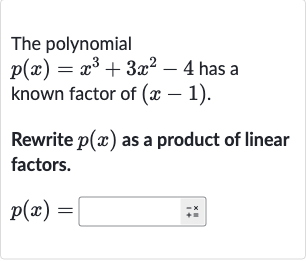AI tutor
Welcome to Bytelearn!
Let’s check out your problem:

The polynomial has a known factor of .Rewrite as a product of linear factors.
Full solution
Q. The polynomial has a known factor of .Rewrite as a product of linear factors.
- Factor Finding: Since we know that is a factor of , we can use polynomial long division or synthetic division to divide by to find the other factors.
- Synthetic Division: Let's perform synthetic division using the root corresponding to the factor , which is .We set up the synthetic division as follows:\begin{array}{r|rrrr} 1 & 1 & 3 & 0 & -4 \ & & 1 & 4 & 4 \ \hline & 1 & 4 & 4 & 0 \end{array}The numbers on the bottom row, after the line, give us the coefficients of the quotient polynomial.
- Quotient Polynomial: The quotient polynomial is . Since the remainder is , this confirms that is indeed a factor of .
- Factoring Quadratic Polynomial: Now we need to factor the quadratic polynomial . This is a perfect square trinomial, which can be factored as .
- Final Expression: Therefore, we can express as a product of its linear factors: .
More problems from Find the inverse of a linear function
QuestionGet tutor help
QuestionGet tutor help
QuestionGet tutor help
QuestionGet tutor help
QuestionGet tutor help
